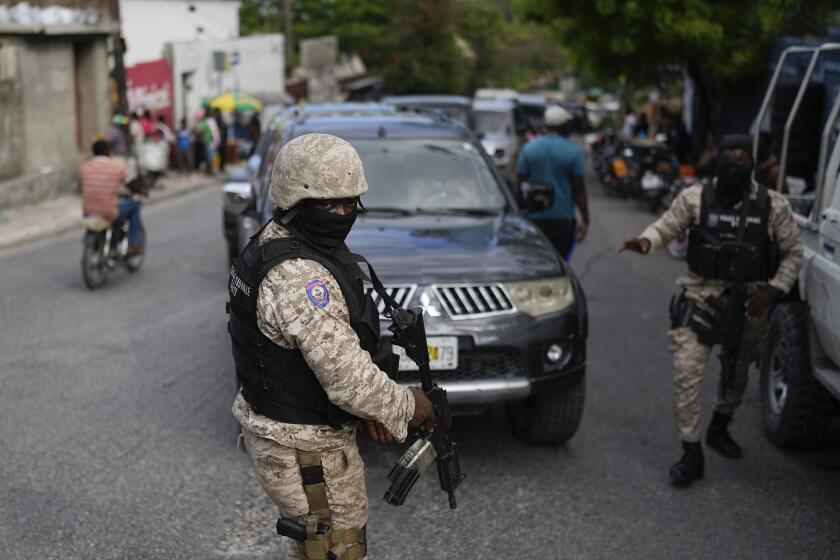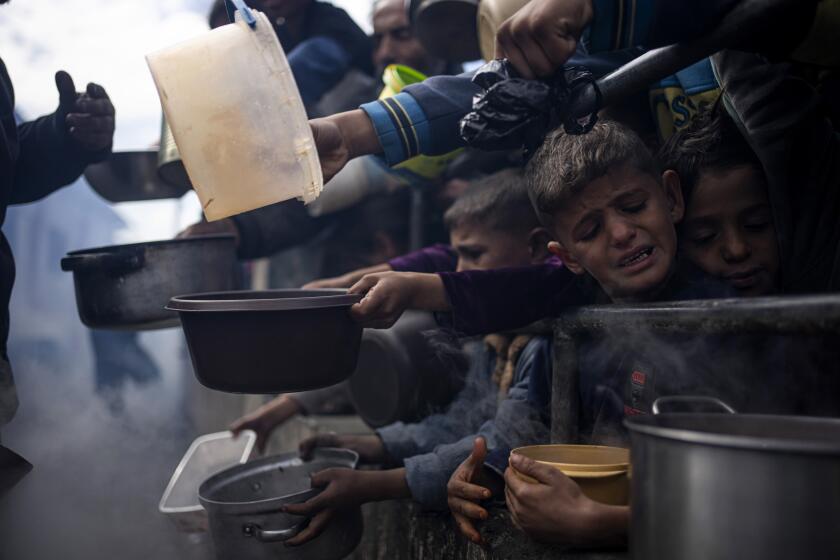Soothing Suffering With Steel
They say there is solace in the steel.
Nineteen months after the attacks on the World Trade Center, Americans have found comfort in the mangled carcass of the twin towers. Steel remnants, bearing the wounds of the tragedy, have become cultural touchstones: the symbols of unified grief and the instruments for collective healing.
“It speaks to your soul,” Mark Ross said of the I-beam -- creased down the middle and puckered along one edge -- that he worked for six months to bring to Martinez, Calif.
Though New Yorkers have publicly, sometimes acrimoniously, debated how to build memorials to 9/11, people in communities from Fawnskin, Calif., to Franklin, N.J., quietly have been getting to work. Across the nation, they have incorporated World Trade Center steel into more than 250 tributes to the dead.
Girders carefully stacked like Lincoln Logs have become the centerpieces of municipal gardens. Church bell towers display an incongruous mix of battered metal and smooth stone. Civic reflecting pools shimmer with wavy images of cold, hard steel.
“Sometimes it takes a physical reminder to convey the spiritual feeling you have for an incident,” said Ross, vice mayor of Martinez, a city of 36,000. “You just need something physical, something more than a plaque.”
For some, the scarred steel shards are like the bones of saints, carefully preserved in gold and silver reliquaries: objects of worship that speak of pain and sacrifice. For others, the metal is a symbol of the bodies that will never be recovered, a rare artifact from a day when America was united in horror and mourning.
“There is this need, this compulsion, to share in the pain and sorrow of New York,” said Emory University religion professor Gary Laderman, an expert on how Americans relate to death. “But there’s something even wider going on, something that has to do with literally finding ways to bind the social body together, to bind the national community together.”
The pieces of steel, he said, “become touchstones for that.”
Builders of monuments to the terrorism victims -- many of whom lack any personal connection to the tragedy -- say they feel a deep sense of patriotism inherent in their work. It is not necessarily an endorsement of the war in Iraq, or even a call to arms for those enforcing homeland security -- although both those views have been expressed. Rather, it is a tribute to the freedoms that so many think were attacked that day.
At the Counterterrorism Training Center in Corinth, Texas, Ron Reid underscored this point as he described the “simple, understated” monument he was building. The 2-foot structural beam, torn almost in two, will sit on a pedestal near the entrance to the private center, which trains law enforcement officers to respond to terrorist attacks.
“Anyone who comes in to training will have to walk past it. I want them to know why they are here.”
*
Not long after the terrorist attacks, a steady stream of letters, e-mails and faxes began arriving at New York’s Office of Emergency Management. It was almost too much to handle, said Francis E. McCarton, a deputy commissioner. Sent by cities, churches and civic groups, they asked for chunks of debris: dust, rocks, steel, anything.
In response, the office and the city’s Community Assistance Unit quietly set aside several hundred pieces of steel for monuments and memorials. New York gave away what it could -- chopping up some girders, leaving others intact, honoring as many requests as possible -- until late 2002, when the supply was exhausted.
The city rebuffed anyone wishing to profit from the tragedy. One man who hoped to make violins out of leftover debris was turned down. Besides, there was little if any wood left from the shattered buildings.
Recipients had to agree never to use their steel for commercial or financial gain, and to acknowledge that it might contain asbestos and other contaminants.
Last May, two public works employees from Lafayette, La., traveled to New York to retrieve a charred, 13-foot piece of steel.
The beam, now cut in two, forms a 1/100-scale model of the towers, which was placed in the city’s Parc Sans Souci in September. Just above the Pentagon-shaped base, a quote from President Bush is translated into Cajun French: “Terrorist attacks can shake the foundations of our biggest buildings, but they cannot touch the foundation of America.”
In July, Father Andrew Harrison drove a rented Ford Windstar 1,600 miles, from Palos Hills, Ill., to New York City and back. His only cargo on the return trip was a 2-foot, 200-pound beam that he had carefully draped with an American flag.
That section of steel, now installed in the narthex of St. Luke Orthodox Church, sits in front of a copper icon of St. Nicholas. (The New York church named after the saint was destroyed when the buildings fell.) A rectangular box on top of the steel holds taper candles, always lighted in remembrance of those who died on 9/11.
A month later, as part of his Eagle Scout project, Ben Narodick persuaded Federal Express to ship for free a 4-foot, 350-pound I-beam to Fountain Valley in Orange County.
That piece, now mounted atop a concrete base that he designed and built with his Boy Scout troop, was placed outside the Fountain Valley public library last October. It took seven members of Fountain Valley High School’s varsity football team to lift the steel into place at the edge of a long, narrow reflecting pool.
“I think the best part about it is the size of it, the fact that it’s intact,” Narodick said. “People don’t expect it.... It brings to mind the first-hand experience. That’s one of the reasons it’s so important the pieces get spread out: to give a firsthand understanding of what happened.”
As the beams crossed the country, on their way to presidential libraries and small-town firehouses, they were greeted with flag-festooned parades and poignant ceremonies.
Father James Moore blessed two of the longest beams before they left New York on a freight truck bound for his church, Sacred Heart in Albuquerque. When they arrived, the Roman Catholic archbishop of Albuquerque consecrated the beams with sacred oil. Sacred Heart Church is in Barelas, one of Albuquerque’s oldest and poorest neighborhoods, just south of downtown. Many of the area’s buildings have been neglected, some abandoned altogether.
“Our neighborhood has kind of died,” said the neighborhood association president, Robert Vigil. But by working together to build the belfry that will house the two World Trade Center beams, the residents of Barelas have become a community again, Vigil said. They are devoting time and energy to raising the $250,000 the church needs to complete the bell tower. They have planned that the beams, each almost 30 feet long, will stand on end, resting against two walls of the tower. So far, about $100,000 has been raised, most in small bills.
Moore marvels at the power the beams hold over all who see them.
When he just touched the beam, Vigil said, “9/11 came back once again. I could picture that day. I could picture everything happening. The fact that lives were lost.”
Every day, three to 10 people visit Sacred Heart’s courtyard, where a beam is on display until the bell tower is completed. Some visitors lay flowers or rosaries at the base of the steel. Others leave pictures and poems.
But most simply touch the beam, say a prayer, and walk away.
“The mixture of blood and bodies and steel and everything that was a part of the twin towers in that moment of horrible devastation ... led to a sacralization of all that material,” Emory professor Laderman said.
These 9/11 memorials have become modern reliquaries: objects that might have been discarded but are now venerated as carriers of spiritual power.
Traditionally, such relics often became centerpieces for churches and temples. The small gothic Sainte-Chapelle in Paris, for example, was built by Louis IX to house what were believed to be the Crown of Thorns and a part of the True Cross.
But though most relics are the artifacts of a lifetime of struggle, the pieces of World Trade Center steel were imbued with historic relevance in a matter of moments.
In Fawnskin, on a small lot across from the North Shore Cafe, one of those pieces, a 2-foot length of I-beam, is perched on five large boulders. Nearby, a five-line poem is posted on a wooden display: “Swift, the unthinkable carnage; / Forever the fall-out of righteousness.... “
The poem was written by entertainer Marty Ingels, who with his wife, actress Shirley Jones, received one of the last pieces of steel from New York City for the park they have donated to Fawnskin, just north of Big Bear Lake.
Ingels said he designed the park to show his support for President Bush. The New York native plans to install a sign behind the beam that says, “Grief Is Not Enough.”
In Martinez, Councilman Ross described the journey of his town’s steel, from rubble to resurrection, as “miraculous.” The 3-foot-long, 2-foot-wide beam was the focal point of the town’s 9/11 commemoration.
For now, the piece sits in the most secure site in Martinez’s Beaux-Arts City Hall: a police evidence locker. A committee will decide how, and where, to build a fitting tribute.
The memorial, Ross said, will serve as a powerful introduction to Martinez, which is the birthplace of Joe DiMaggio.
“We are a very diverse community, perhaps as diverse as the World Trade Center was in its occupants.... We just want people to know that we haven’t forgotten. There’s always time to pause and reflect on that moment, and what it means to us -- not just the past, but where should we go from here.”
More to Read
Start your day right
Sign up for Essential California for news, features and recommendations from the L.A. Times and beyond in your inbox six days a week.
You may occasionally receive promotional content from the Los Angeles Times.






